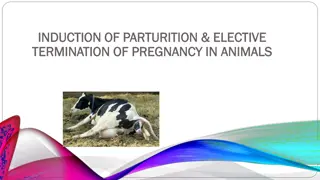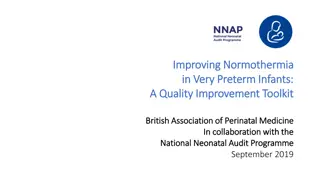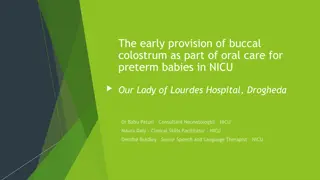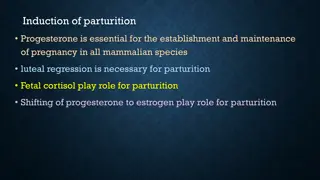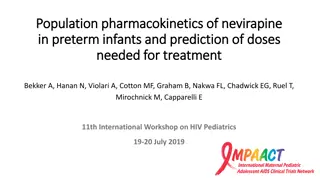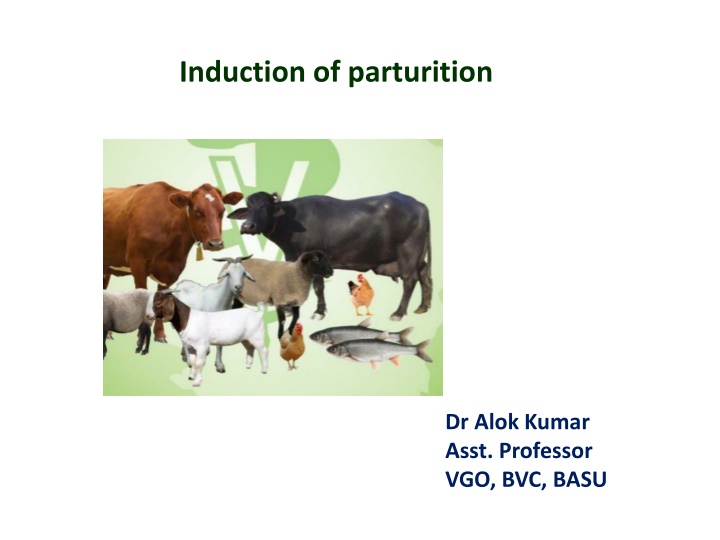
Induction of Parturition: Protocols and Considerations
Learn about the induction of parturition in cattle, including indications, timing, protocols involving corticosteroids and prostaglandins, and potential outcomes. Proper administration and timing are crucial for successful outcomes. Find out more about the process and its implications for cattle health and safety.
Download Presentation

Please find below an Image/Link to download the presentation.
The content on the website is provided AS IS for your information and personal use only. It may not be sold, licensed, or shared on other websites without obtaining consent from the author. If you encounter any issues during the download, it is possible that the publisher has removed the file from their server.
You are allowed to download the files provided on this website for personal or commercial use, subject to the condition that they are used lawfully. All files are the property of their respective owners.
The content on the website is provided AS IS for your information and personal use only. It may not be sold, licensed, or shared on other websites without obtaining consent from the author.
E N D
Presentation Transcript
Induction of parturition Dr Alok Kumar Asst. Professor VGO, BVC, BASU
Pre-term induction of parturition/calving Indications: Pasture availability Availability of skilled labour Reduced body weight and size - fetomaternal disproportion Pathological condition - termination alleviation of condition of dam
Period of induction Induction should be carried out after 260 to 265 days to a apparently healthy cow. In pathogenic condition, can be done at any stage Induction before 95% of the breed s normal gestation may lead to Birth of a small, weak calf Poor chances of survival
Protocol of induction Administration of corticosteroid Short, medium and long acting corticosteroids can be administered. The effectiveness of the corticosteroid is believed to be dependent on the Permeability of the ruminant placenta to the molecule. In cows, corticosteroid can apparently be active for more than a month before full term. At a normal therapeutic dose rate S no. Type of corticosteroid Latent period (in days) 1 Long acting 11 - 18 2 Medium acting 5 - 11 ( 3 Short acting 1 - 6
Conti Dexamethasone, Betamethasone and flumethasone produces reliable and predictable results Most commonly used is Betamethasone at total dose 35 mg. Short acting corticosteroid less effective RFM remains a consistent feature Calf viability is more Long acting corticosteroid high perinatal mortality rate. Corticosteroids are also immunosuppressive combined with Broad spectrum antibiotics
Administration of Prostaglandins PGF2 and the analogues have been successfully used from about 275 days of gestation with a latent period of 2 to 3 days. Good results have been obtained by using a combination of corticosteroid and prostaglandin. Experimental use of the progesterone receptor antagonist i.e. aglepristone demonstrated 1. Initiation of calving with cervical opening but impaired expulsion of the calves due to insufficient myometrial contractility.
Protocol 1 (250-260 days of gestation) long-acting corticosteroid Absence of calving for 8 days short-acting corticosteroid or PGF2 Protocol 2 ( after 270 days of gestation) medium-acting corticosteroid Absence of calving for 8 days either a short-acting corticosteroid or PGF2 After 275 days of gestation PGF2 or short- or medium-acting corticosteroids are effective on their own
BUFFALOES Protocol A (Gestation length less than 300 ) Dexamethasone 20 mg + PGF2Alpha 25 mg, i/m Protocol B (Gestation length more than 300 ) Dexamethasone 20 mg , i/m Protocol C (Gestation length 290-295) Estrumate 750 g + Dexamethasone 40mg. IM
Protocol 3 (Clinical reports- pathological conditions in cows and buffaloes) Intramuscular administration of following therapeutic agents: synthetic prostaglandin (PGF2 ) i.e. Cloprostenol Na @ 500 ug. Valethamate bromide @ 48 mg. Dexamethasone @40 mg. Estradiol valerate @ 30mg. Disadvantages of preterm induction of calving: It is not always effective. The birth weight of the calf is lower than it would have been at term There is also a high incidence of retained fetal membranes, up to 53% when short-acting preparations are used
contin. Hartmann et al., 2013. observed that even inductions close to term pregnancy may still result in a high incidence of placental retention Milk yield is initially affected, with a delay in reaching peak lactation, very little influence on the overall yield. Subsequent fertility is fairly normal . However Cows having RFM may have high 1. 2. calving to conception interval number of services per conception There is a reduction in the quality and quantity of colostral immunoglobulins (mostly after use of slow-release corticosteroid preparations. However calves passive immunity remains unaffected
Pre-term induction of foaling Availability of skilled labours Pathological condition of mare. Preparation before induction Examine degree of relaxation of SC ligament and cervix Ionic composition of mammary secretion
Induction with oxytocin Based on Direct stimulatory on myometrium Indirect stimulation of uteroplacental prostaglandin release. Protocol Ripened cervix with finger dilation I/M administration of 120 IU oxytocin 360 to 600 kg mare. Foaling within 15 to 60 minutes
Induction with Corticosteroids Dexamethasone administration Preferable for ponies and large saddle type mares Protocol 100 mg/day for 4 days Foaling after 6-7 days from start of treatment
Induction with prostaglandin PGF2 1.5 to 2.5 mg every 12 hours Fluprostenol Period 322 and 367 days Dose rate 250 g to ponies 1000 g to throughbred
Pre- term induction of farrowing On average 5% to 7% of all piglets are stillborn Interval between the birth of the first and last piglets is associated with the stillbirth rate. Prolonged farrowing may results in an increase, probably 80% of the stillbirths The stillbirth rate can be reduced by intensive care and attention during farrowing. Major constrain is the difficulty in prediction of time of farrowing. Solution induction of farrowing of groups of sows at predetermined times facilitates availability of skilled
Pre- term induction of farrowing. Contin.. Group farrowing facilitates multiple suckling and allows crossfostering to take place. (spl. In cases of MMA) Groups of sows and litters can be managed on an all in, all out principle, therefore more hygienic management can be practiced Group farrowing facilitates group weaning. It might increase the reproductive efficiency by reducing the farrowing interval by a few days.
Protocols Intramuscular administration of natural PGF2 or a synthetic analogue i.e. Cloprostenol, on days 111 to 113 of gestation Farrowing will occur on average 28 hours later. Thus, if procedure followed at 8 or 10 AM - majority of sows will farrow during normal working hours. Combination therapy with administration of 20 IU of oxytocin 24 hours post PG administration was tried with moderate effect In recent times Use of vulvar injections of a split-dose (50% of the label dose at a 6-hour interval) was recommended to obtain a higher proportion of responding sows.
Pre- term induction of Lambing The indications for pre-term induction are limited because dystocia due to fetomaternal disproportion is not as common as in cows. However, lambing at day time with available skilled labor is important indication Limitation Shortening of gestation length by more than 7 to 10 days may lead to increased lamb mortality. Protocol 1. Administration of Corticosteroid corticosteroids such as dexamethasone, flumethasone, and betamethasone are given by a single I/M injection within 5 days of term, normal parturition occurs in 2 to 3 days.
Protocol 2. Administration of 3-hydroxysteroid dehydrogenase inhibitor. Epostone administration via oral, I/V, or I/M route between days 136 and 142, birth of viable lambs occurred between 33 to 36 hours after application. Protocol 3. Administration of progesteron receptor antagonist. I/M injection of RU 486, both on day 144 and 145 days of pregnancy, significantly advanced the birth of viable lambs. Very recently Two injections (on day 140 and 141) of aglepristone (5 or 10 mg/kg body weight) Precisely controlled the lambing time without any adverse side effects in either mothers or lambs.
Pre- term induction of Kidding Preterm induction of parturition in goats can be achieved by administration of Luteolytic dose of natural prostaglandin F2 Synthetic analogues Cloprostenol . Parturition of 80% of the treated animals commenced 30 and 40 hours post treatment on day 145 of gestation. Unlike cattle Dystocia and retention of the fetal membranes did not occur
Summary Preterm induction of parturition in farm animal often required and can be practiced with precautions based on indications. More research in this area with various protocols may facilitate better farm management with less chances of dystocia and perinatal deaths.
Thank you Thank you





